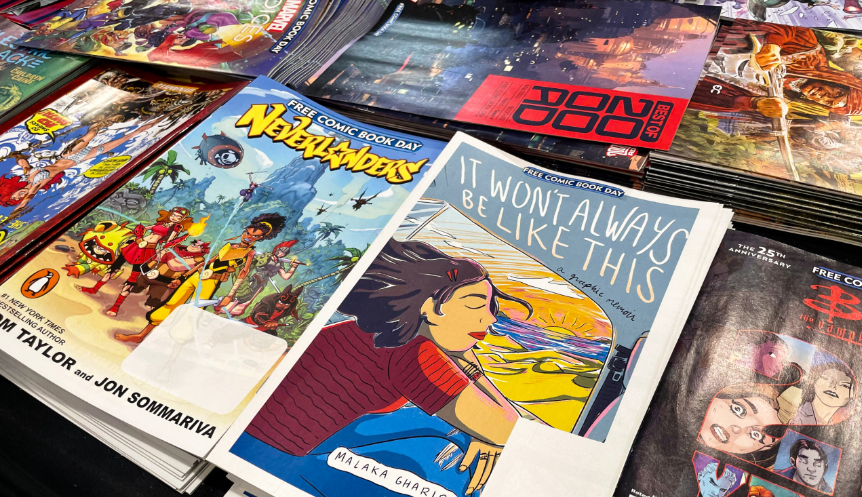Entertainment
komik Hisashiburi ni Jikka ni Kaettara, Otouto ga Ts Shiteta: A Komik Story
Published
2 years agoon
By
Jack
Table of Contents
ToggleUnderstanding the Context: The Story’s Background
Every great story is rooted in a rich context that shapes its narrative and gives it deeper meaning. In the case of “Hisashiburi ni Jikka ni Kaettara, Otouto ga Ts Shiteta: A Komik Story”, the context serves as a foundation for the events that unfold throughout the story.
The story is set in a small, rural town in Japan, where time seems to move at a slower pace. The town is known for its picturesque landscapes, with cherry blossom trees lining the streets and traditional wooden houses dotting the landscape. This idyllic setting provides a sense of tranquility and nostalgia, setting the stage for the protagonist’s return home after a long absence.
The protagonist, Hiroshi, is a young man who left his hometown years ago in pursuit of his dreams. He ventured into the bustling city, seeking opportunities and a chance to make a name for himself. However, the fast-paced city life and the constant pressure to succeed took a toll on Hiroshi, leaving him feeling disconnected from his roots.
The Meaning Behind the Title
The title, which translates to “When I Returned Home After a Long Time, My Younger Brother Had Done Something,” hints at the surprise and anticipation that the protagonist experiences upon their return. It sets the stage for a story filled with unexpected twists and turns.
As Hiroshi steps foot in his hometown, he is greeted by a wave of nostalgia and a sense of longing. Memories flood his mind as he walks the familiar streets, reminiscing about his childhood adventures and the bond he shared with his younger brother, Takeshi. However, Hiroshi soon discovers that things have changed in his absence, and his brother’s actions have had a profound impact on the lives of those around them.
The Cultural Significance of the Story
This story holds great cultural significance as it explores the complexities of family dynamics and the societal pressure placed on individuals to conform to certain expectations. By delving into these cultural themes, the story resonates with readers on a universal level.
In Japanese culture, the concept of filial piety, or respect for one’s parents and elders, holds great importance. The story delves into the tension between Hiroshi and Takeshi, highlighting the clash between tradition and personal aspirations. It explores the expectations placed on individuals to follow a predetermined path, often sacrificing their own dreams in the process.
Furthermore, the story sheds light on the notion of “giri,” a Japanese term that refers to the sense of duty and obligation towards one’s family. Hiroshi’s return home forces him to confront his own sense of giri and grapple with the choices he has made. Through his journey, readers are invited to reflect on their own cultural values and the sacrifices they may have made in pursuit of their dreams.
The Characters: A Closer Look
Central to every story are its characters, and “Hisashiburi ni Jikka ni Kaettara, Otouto ga Ts Shiteta: A Komik Story” is no exception. Let’s take a closer look at the key players who bring this tale to life.
The Protagonist’s Journey
The protagonist, named Hiroshi, embarks on a transformative journey as they navigate the complexities of returning home after a long absence. Hiroshi’s story is one of self-discovery and emotional growth, as they grapple with the challenges of reconnecting with their family and reestablishing their place in the community. The readers are captivated by Hiroshi’s internal struggles and external conflicts, which make them relatable and endearing.
As Hiroshi delves deeper into their past, they uncover buried memories and unresolved emotions, leading to a profound understanding of themselves and their roots. Through encounters with old friends and acquaintances, Hiroshi learns valuable life lessons and gains a newfound appreciation for the importance of family and home. This journey of self-reflection and personal growth resonates with readers, who find solace and inspiration in Hiroshi’s experiences.
The Transformation of the Younger Brother
The younger brother, named Kazuki, plays a pivotal role in “Hisashiburi ni Jikka ni Kaettara, Otouto ga Ts Shiteta: A Komik Story.” Initially overshadowed by Hiroshi’s return, Kazuki’s character undergoes a remarkable transformation throughout the story. As the narrative unfolds, Kazuki emerges as a dynamic presence, challenging societal norms and exploring his own identity.
Driven by a desire to break free from the constraints of traditional expectations, Kazuki embarks on a journey of self-discovery. He experiments with different hobbies, explores new friendships, and questions the status quo. Kazuki’s transformation is not only a rebellion against societal norms but also a search for his own voice and individuality.
Through his experiences, Kazuki learns to embrace his true self, unapologetically expressing his passions and interests. His journey inspires readers to reflect on their own lives and encourages them to pursue their dreams, regardless of societal expectations.
As the story progresses, the bond between Hiroshi and Kazuki strengthens, and their individual journeys intertwine. Together, they navigate the challenges of family dynamics, cultural expectations, and personal growth. Their relationship serves as a powerful reminder of the importance of love, acceptance, and understanding in overcoming obstacles and finding one’s place in the world.
Plot Analysis: Unraveling the Narrative
With its unpredictable twists and intertwined storylines, “Hisashiburi ni Jikka ni Kaettara, Otouto ga Ts Shiteta: A Komik Story” presents an intriguing narrative that keeps readers on the edge of their seats.
Key Plot Points
The story unfolds through a series of key plot points that heighten the tension and propel the story forward. From unexpected family reunions to secretive discoveries, each plot point adds layers of intrigue, ensuring readers are fully engaged.
One of the most captivating plot points is when the protagonist, Hiroshi, stumbles upon a hidden diary in the attic of his childhood home. As he flips through the pages, he uncovers a long-buried family secret that threatens to unravel everything he thought he knew about his past. This revelation not only adds a thrilling element to the narrative but also raises questions about identity and the complexities of family dynamics.
Another pivotal moment in the story occurs when Hiroshi’s long-lost brother, Takeshi, unexpectedly returns after years of absence. This reunion sparks a series of events that force Hiroshi to confront his own insecurities and reevaluate his relationships. The emotional turmoil that ensues adds depth to the characters and allows readers to connect with their struggles on a personal level.
The Role of Humor in the Story
Incorporating humor into the narrative, the story balances its serious themes with moments of levity. The clever use of comedic relief allows readers to connect with the characters on a deeper level, fostering an emotional bond that further enhances the storytelling.
One memorable instance of humor is when Hiroshi’s eccentric neighbor, Mr. Tanaka, accidentally mistakes a jar of pickles for a jar of paint and ends up creating a hilarious mess in his living room. This comedic interlude not only provides a lighthearted break from the intense plot but also showcases the diverse personalities within the story.
Furthermore, the banter between Hiroshi and his best friend, Yuki, adds a touch of wit and charm to the narrative. Their playful exchanges and witty one-liners inject moments of laughter, creating a well-rounded reading experience that appeals to a wide range of emotions.
Themes and Symbolism in the Story
“Hisashiburi ni Jikka ni Kaettara, Otouto ga Ts Shiteta: A Komik Story” is a captivating narrative that delves into a multitude of themes, offering readers valuable insights into the complexities of the human experience. Through its exploration of various central themes, the story resonates with readers on a profound level, encouraging introspection and fostering a sense of shared understanding.
One of the central themes that permeates the story is the concept of family. The intricate dynamics of familial relationships are masterfully portrayed, allowing readers to reflect on their own experiences and connections. The protagonist’s journey home after a long absence serves as a catalyst for exploring the intricate web of emotions that bind families together. Through this exploration, readers are reminded of the universal nature of family bonds and the power they hold in shaping our identities.
Identity is another theme that takes center stage in this compelling story. As the protagonist navigates the challenges of returning home, they are confronted with questions of self-discovery and personal growth. The narrative beautifully captures the complexities of identity formation, highlighting the internal struggles and external influences that shape who we are. Readers are invited to reflect on their own journeys of self-discovery, deepening their connection to the story and its characters.
Societal expectations also play a significant role in the narrative, adding another layer of depth to the story’s exploration of themes. The protagonist’s return to their hometown brings them face-to-face with the pressures and expectations imposed by society. Through thought-provoking interactions and poignant moments, readers are prompted to examine the impact of societal norms on individual lives. This exploration serves as a powerful reminder of the importance of staying true to oneself amidst external pressures.
Symbolism is skillfully employed throughout the story, enriching the narrative and leaving a lasting impression on readers. Objects and motifs take on deeper meanings, representing emotional connections and pivotal moments in the characters’ lives. The recurring image of a cherry blossom tree, for example, symbolizes the transient nature of life and the beauty that can be found in fleeting moments. Such symbolism adds layers of complexity to the story, inviting readers to engage with the text on a deeper level and uncover hidden depths.
Metaphorical elements also contribute to the story’s impact, mirroring the growth and transformation of the characters. The protagonist’s journey home becomes a metaphorical journey of self-discovery and reconciliation. Through vivid descriptions and evocative language, readers are transported into the protagonist’s world, experiencing their triumphs and tribulations firsthand. This use of metaphorical storytelling adds a sense of universality to the narrative, allowing readers to connect with the characters and their struggles on a profound and empathetic level.
In conclusion, “Hisashiburi ni Jikka ni Kaettara, Otouto ga Ts Shiteta: A Komik Story” is a thought-provoking tale that explores a wide range of themes and employs symbolism to enhance its impact. Through its nuanced exploration of family, identity, and societal expectations, the story offers readers valuable insights into the human experience. By delving into the complexities of these themes and utilizing symbolism to deepen the narrative, the story captivates readers and leaves a lasting impression.
The Art of Komik Storytelling
As a unique form of storytelling, komik holds a distinctive allure that sets it apart from other mediums. “Hisashiburi ni Jikka ni Kaettara, Otouto ga Ts Shiteta: A Komik Story” harnesses the power of komik to captivate readers.
The Unique Style of Komik Narration
The story’s narrative structure, complete with its panel layouts and visual storytelling techniques, showcases the artistry of komik. The seamless integration of images and dialogue allows for a deeply immersive reading experience, where the visuals enhance the emotional impact of the story.
The Influence of Komik on the Story’s Appeal
Komik’s influence goes beyond the aesthetics, contributing to the story’s overall appeal. It offers a playful and engaging way to experience the narrative, inviting readers to actively participate and interpret the story through their own lens.
Author

